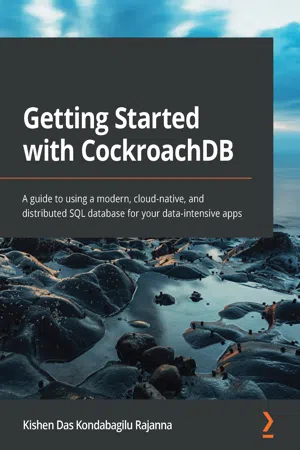
Getting Started with CockroachDB
A guide to using a modern, cloud-native, and distributed SQL database for your data-intensive apps
- 246 pages
- English
- ePUB (mobile friendly)
- Available on iOS & Android
Getting Started with CockroachDB
A guide to using a modern, cloud-native, and distributed SQL database for your data-intensive apps
About This Book
Get hands-on with deploying and managing your database services to provide scalable and high-speed data access on CockroachDB
Key Features
- Gain insights into CockroachDB and build highly reliable cloud-native applications
- Explore the power of a scalable and highly available cloud-native SQL database to distribute data and workloads automatically
- Build high-speed database services using CockroachDB and troubleshoot performance issues
Book Description
Getting Started with CockroachDB will introduce you to the inner workings of CockroachDB and help you to understand how it provides faster access to distributed data through a SQL interface. The book will also uncover how you can use the database to provide solutions where the data is highly available.
Starting with CockroachDB's installation, setup, and configuration, this SQL book will familiarize you with the database architecture and database design principles. You'll then discover several options that CockroachDB provides to store multiple copies of your data to ensure fast data access. The book covers the internals of CockroachDB, how to deploy and manage it on the cloud, performance tuning to get the best out of CockroachDB, and how to scale data across continents and serve it locally. In addition to this, you'll get to grips with fault tolerance and auto-rebalancing, how indexes work, and the CockroachDB Admin UI. The book will guide you in building scalable cloud services on top of CockroachDB, covering administrative and security aspects and tips for troubleshooting, performance enhancements, and a brief guideline on migrating from traditional databases.
By the end of this book, you'll have gained sufficient knowledge to manage your data on CockroachDB and interact with it from your application layer.
What you will learn
- Become well-versed with the overall architecture and design concepts of CockroachDB
- Understand how auto-rebalancing of data can avoid performance bottlenecks
- Get to know how CockroachDB achieves atomicity, consistency, isolation, and durability
- Partition your data across multiple geolocations to ensure very low latency when serving data
- Find out how indexes are stored and the optimizations used to serve query results faster
- Discover the key concepts of deploying and managing CockroachDB clusters
Who this book is for
Software engineers, database developers, database administrators, and anyone who wishes to learn about the features of CockroachDB and how to build database solutions that are fast, highly available, and cater to business-critical applications, will find this book useful. Although no prior exposure to CockroachDB is required, familiarity with database concepts will help you to get the most out of this book.
Frequently asked questions
Information
Section 1: Getting to Know CockroachDB
- Chapter 1, CockroachDB - A Brief Introduction
- Chapter 2, How Does CockroachDB Work Internally?
Chapter 1: CockroachDB – A Brief Introduction
- The history and evolution of databases
- Database concepts
- CAP theorem
- CockroachDB
The history and evolution of databases
SQL
Object-oriented databases
NoSQL
NewSQL
Table of contents
- Getting Started with CockroachDB
- Contributors
- Preface
- Section 1: Getting to Know CockroachDB
- Chapter 1: CockroachDB – A Brief Introduction
- Chapter 2: How Does CockroachDB Work Internally?
- Section 2: Exploring the Important Features of CockroachDB
- Chapter 3: Atomicity, Consistency, Isolation, and Durability (ACID)
- Chapter 4: Geo-Partitioning
- Chapter 5: Fault Tolerance and Auto-Rebalancing
- Chapter 6: How Indexes Work in CockroachDB
- Section 3: Working with CockroachDB
- Chapter 7: Schema Creation and Management
- Chapter 8: Exploring the Admin User Interface
- Chapter 9: An Overview Of Security Aspects
- Chapter 10: Troubleshooting Issues
- Chapter 11: Performance Benchmarking and Migration
- Appendix: Bibliography and Additional Resources
- Other Books You May Enjoy